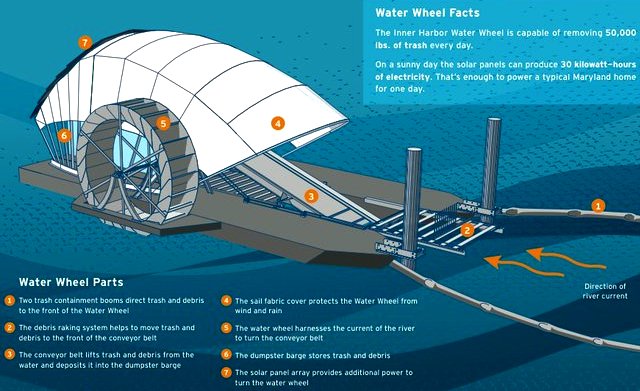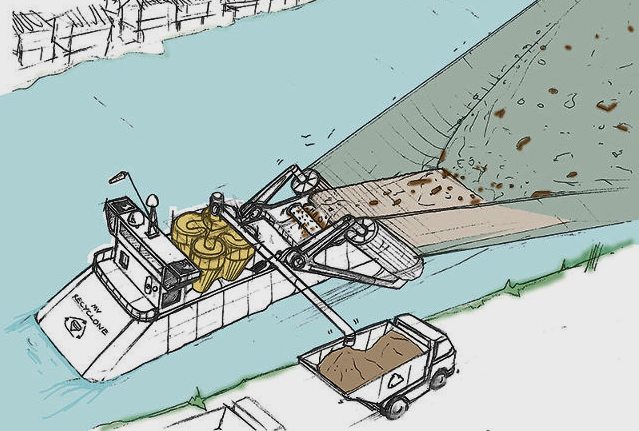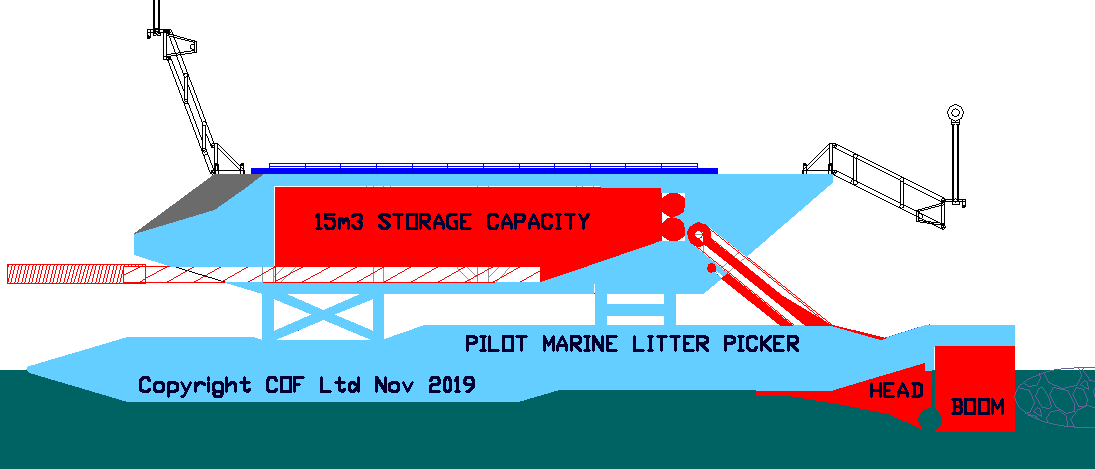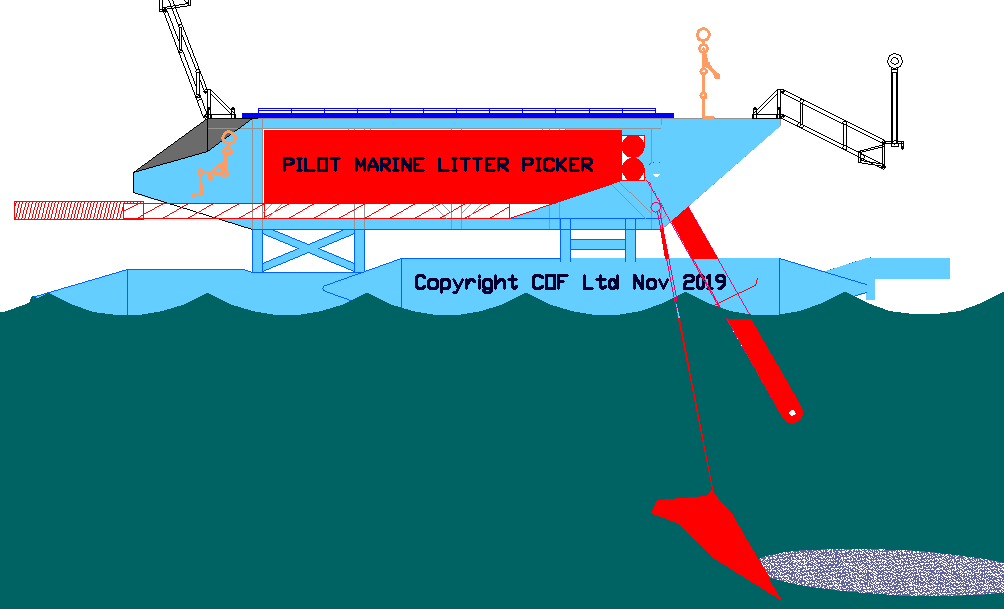|
BALTIMORE - HARBOR RIVER CLEANING WATER WHEEL
Please use our A to Z INDEX to navigate this site
|
|
|
MR TRASH - Two floating booms direct river debris to the front of the water wheel. A raking system helps move trash onto a conveyor belt that dumps it into a barge at the rear. A solar panel array keeps the wheel moving when the river flow is reduced. All in all a nice bit of engineering. KISS
JULY 2014 - TREEHUGGER: BALTIMORE RIVER WATER WHEEL - MR TRASH
Looking for all the world like a western buggy, crossed with a river boat paddle steamer, this very practical vessel has proved what it can do and passed the tests with flying colors. It certainly deserves it's title: Mr Trash and much respect.
The MV RECYCLONE - From James Dyson. We like it. But we're not sure that cyclonic separation is good for an ocean cleaner with lesser energy available. It is though the experimental base. Not only has a system to work, but it must also be cost effective. James is an inspirational example of a man who thinks progressively of a better future. The drawing above was sketched for Time magazine. Apart from the cyclonic filters, the concept is not that far removed from Baltimore's Mr Trash above.
There are a number of builders of river skimmers, mostly using the same technology, as in a driven wire mesh to escalate the floating debris and deposit it in a skip behind. The above picture shows this well. Is it though diesel powered and needs a driver. Thus, it is unsuitable for blue water ocean cleaning projects, where the fuel and crew costs would make such concepts uneconomical.
LINKS
Treehugger solar water wheel could be solution plastic ocean debris Fast Coexist James Dyson is designing a giant vacuum on a barge to clean ocean trash Telegraph James Dyson suggests leaving the EU over vacuum cleaners Boats gallery Rotork Sea Truck Wired Magazine 2011 the seventh disruption James Dyson Daily
Mail Dyson's mission a vacuum cleaner for rivers inventor sketches plans
suction remove plastic debris http://www.treehugger.com/clean-technology/solar-water-wheel-could-be-solution-plastic-ocean-debris.html http://time.com/23059/dames-dyson-sweep-our-dirty-rivers-clean/ http://www.jamesdysonfoundation.co.uk/ http://www.jamesdysonaward.org/ http://www.wired.co.uk/magazine/archive/2011/11/features/the-seventh-disruption-james-dyson/page/3 http://www.techdigest.tv/2013/02/dysons_top_10_b.html http://en.wikipedia.org/wiki/Sea_Truck http://en.wikipedia.org/wiki/Rotork http://www.rotork.com/en/ http://en.wikipedia.org/wiki/James_Dyson http://www.dyson.co.uk/community/james-dyson-foundation.aspx http://www.dyson.co.uk/
Our love affair with plastic is choking the oceans. Once people know about it, they want to stop it. But how? The next question is who? Obviously, if any of the researchers involved so far had come up with a solution, they would have sorted it years ago. We are a practical think-tank fresh to the issue and without a budget. We hope to be able to collaborate with other marine organisations that are funded for this work, or who have funds to investigate viable projects. You cannot donate to us directly on this site, but we hope to identify partner sites shortly where you can support a project much like that proposed herein, or better still, our own practical experiments with the SeaVax concept.
SEAVAX 'PILOT' LITTER PICKER - This is a 16 meter version of SeaVax. In these diagrams we are looking through the superstructure from the side of the vessel. [Left] We can see a boom ahead of the cleaning head on the right, guiding marine litter and plastic into the filtration head in surface skim mode, where it is lifted up into the large storage chamber by a conveyor, then carried to a harbour for offloading and treatment. [Right] In this diagram we see the selective filter cleaning head lowered to a depth of 8 meters to deal with deeper historic plastics on riverbeds and other coastal areas.
The vessel is designed to navigate itself to a designated location, with input from human operators, where a dockside container system for convenient recycling allows speedy turnarounds. These cleaning machines may be moored in rivers to collect plastic, a strategy that was proposed in 2016 - hence the A-Z of dirty rivers. Copyright © diagrams 21 & 25 November 2019. All rights reserved, Cleaner Ocean Foundation Ltd.
ACIDIFICATION - ADRIATIC - ARCTIC - ATLANTIC - BALTIC - BAY BENGAL - BERING - CARIBBEAN - CORAL - EAST CHINA ENGLISH CH - GOC - GULF GUINEA - GULF MEXICO - INDIAN - IOC - IRC - MEDITERRANEAN - NORTH SEA - PACIFIC - PERSIAN GULF - SEA JAPAN STH CHINA - PLASTIC - PLANKTON - PLASTIC OCEANS - SEA LEVEL RISE - UNCLOS - UNEP - WOC - WWF
AMAZON - BURIGANGA - CITARUM - CONGO - CUYAHOGA - GANGES - IRTYSH - JORDAN - LENA - MANTANZA-RIACHUELO MARILAO
- MEKONG - MISSISSIPPI - NIGER - NILE - PARANA - PASIG - SARNO -
THAMES -
YANGTZE - YAMUNA - YELLOW
Youtube Mr Trash
|
|
|
This website is Copyright © 2015 Bluebird Marine Systems Ltd. The names Bluebird, Bluefish, Ecostar DC50, Miss Ocean, SeaNet, SeaVax and the blue bird and fish in flight logos are trademarks. CONTACTS The color blue is a protected feature of the trademarks.
|





